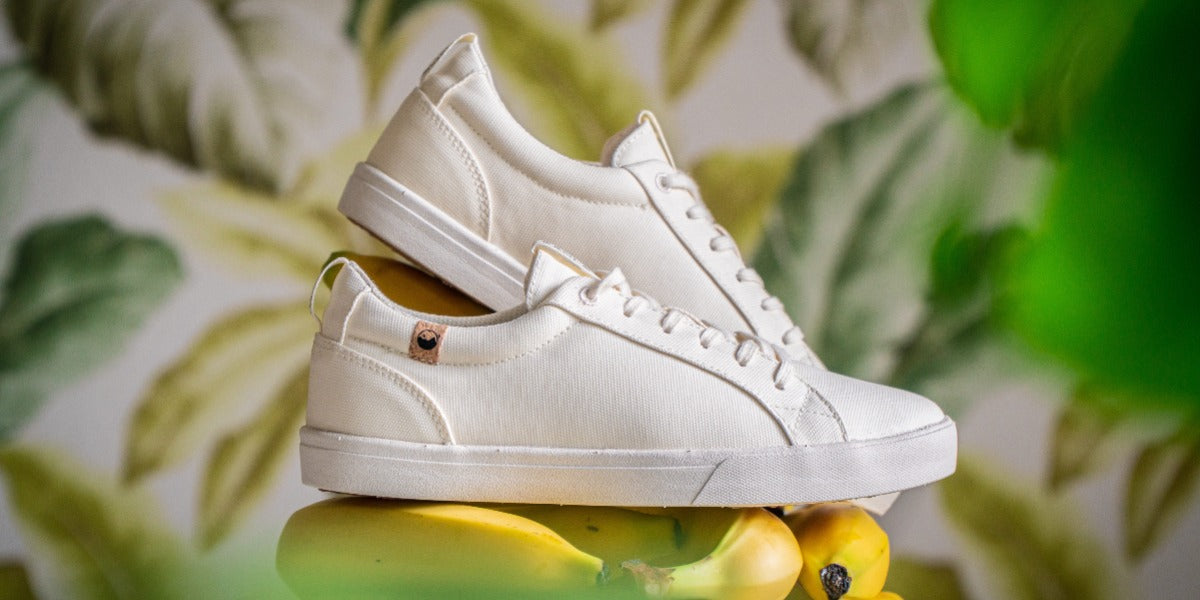100% Vegan Leather. Sounds like an oxymoron, right?

The fashion industry, as you know, is one of the a largest industries, and 2nd most polluting behind oil and gas. Recently, new generations of consumers are shedding light on the effects of fashion consumption, or fast fashion, and hoping to turn the negative effects of our need for the newest and greatest styles, around.
So enter leather. We know it for it's qualities and why it's used in textiles, but what is the inside scoop?? Here we go....

LEATHER
Leather comes from animals. It is mainly used in the clothing industry because, once treated with toxic products (formaldehyde, tar derivatives, cyanide-based dyes and other dangerous substances), this material outlasts other alternatives, making it durable and weather resistant. And you guessed it, ideal for shoes. These chemicals, however, are not good for your health.
Most of the leather we use in fashion comes from Asia, especially China and India. Made halfway around the world for us Westerners, it's very difficult to really know where the leather we're wearing comes from. But here's the data. Billions of animals are killed each year to meet the demands of the fashion industry. And it's not just cows. PETA reports that around 2,000,000 dogs are killed for leather every year.
Are warm, stylish feet worth the ethical compromise? We don't think so.
Enter Vegan Leather.
LEATHER ALTERNATIVES

RECYCLED PLASTIC BOTTLES (OR RECYCLED PET)
PET comes from the abbreviation "transparent polyethylene terephthalate." More simply put, it is recycled plastic bottles, which equates to millions of bottles each year.
By recycling this waste, we can transform bottles into new materials. The process is simple: bottles are collected from the oceans or dumpsters, melted, then transformed into into yarn. At SAOLA, we are able to make the upper of our eco-friendly shoes from 90% recycled plastic bottles (see pic above!).

RECYCLED PLASTIC BOTTLES (OR RECYCLED PET)
PET comes from the abbreviation "transparent polyethylene terephthalate." More simply put, it is recycled plastic bottles, which equates to millions of bottles each year.
By recycling this waste, we can transform bottles into new materials. The process is simple: bottles are collected from the oceans or dumpsters, melted, then transformed into into yarn. At SAOLA, we are able to make the upper of our eco-friendly shoes from 90% recycled plastic bottles (see pic above!).

VEGAN LEATHER FROM GRAPES
Not only good for wine, grapes are also being used in the textile industry.
Vegea, an Italian company, realized that out of the 26 billion liters of wine produced each year, the waste of grape stems, skin and seeds could be reused and repurposed.
The result? A 100% natural and eco-friendly material for vegan shoes.
Find out more on vegan grape-based leather here.

PINATEX: LEATHER VEGAN LEAF
The brain-child of Carmen Hijosa, this new alternative is made from pineapple leaves. Say, what?
Hijosa has worked in the clothing industry for a long time. no stranger to the ecological and human problems associated with animal leather. Her solution? Use the 13 million tonnes of waste from pineapple production to create a new alternative to leather. Brands such as Hugo Boss and Lancel have already taken an interest in this material, which isn't too crazy when you consider that the material 20% cheaper than animal leather.
MUSHROOMS
No, you're not tripping, mushrooms can be made into textiles too!
Created in 2013 by Philipp Ross, Myco Works is an American start-up that campaigns against leather. Columbia and Berkeley have already got their hands on this ingenious process which uses the properties of the mycelium from fungi. Heated to very high temperatures in molds, this new material will likely take the place of crocodile leather in the years to come! Stay tune.
EUCALYPTUS
Eucalyptus, a favorite food of Koalas, is not only used for its natural benefits in medicine. Added to recycled PET, some brands have already succeeded in making belts. The advantage? It is a 100% vegan leather, durable and resistant, and an animal-friendly alternative.

CORK
While we use cork as a main material in our insoles, it is also possible to use it in the upper materials as well. When cork (which is sustainably farmed) is worked and transformed into fabric, the end product is very light and waterproof, a practical alternative to leather.
Want more? Cork is also a bio-degradable material.
OTHER VEGAN LEATHER ALTERNATIVES ARE OUT THERE
This is just the beginning, the list goes on and on. While we are always on the lookout for new and environmentally-friendly materials, give a shout should you come across any we've never heard of! We'd love to learn more.
Hijosa has worked in the clothing industry for a long time. no stranger to the ecological and human problems associated with animal leather. Her solution? Use the 13 million tonnes of waste from pineapple production to create a new alternative to leather. Brands such as Hugo Boss and Lancel have already taken an interest in this material, which isn't too crazy when you consider that the material 20% cheaper than animal leather.
MUSHROOMS
No, you're not tripping, mushrooms can be made into textiles too!
Created in 2013 by Philipp Ross, Myco Works is an American start-up that campaigns against leather. Columbia and Berkeley have already got their hands on this ingenious process which uses the properties of the mycelium from fungi. Heated to very high temperatures in molds, this new material will likely take the place of crocodile leather in the years to come! Stay tune.
EUCALYPTUS
Eucalyptus, a favorite food of Koalas, is not only used for its natural benefits in medicine. Added to recycled PET, some brands have already succeeded in making belts. The advantage? It is a 100% vegan leather, durable and resistant, and an animal-friendly alternative.

CORK
While we use cork as a main material in our insoles, it is also possible to use it in the upper materials as well. When cork (which is sustainably farmed) is worked and transformed into fabric, the end product is very light and waterproof, a practical alternative to leather.
Want more? Cork is also a bio-degradable material.
OTHER VEGAN LEATHER ALTERNATIVES ARE OUT THERE
This is just the beginning, the list goes on and on. While we are always on the lookout for new and environmentally-friendly materials, give a shout should you come across any we've never heard of! We'd love to learn more.



